Omaha residents, have you ever wondered about the spiders you encounter in your backyard or basement? At Scott’s Pest Control, we believe in educating our community about these fascinating creatures. Using the comprehensive “Identification Guide to Common Spiders in Nebraska,” we’ve compiled essential information for you.
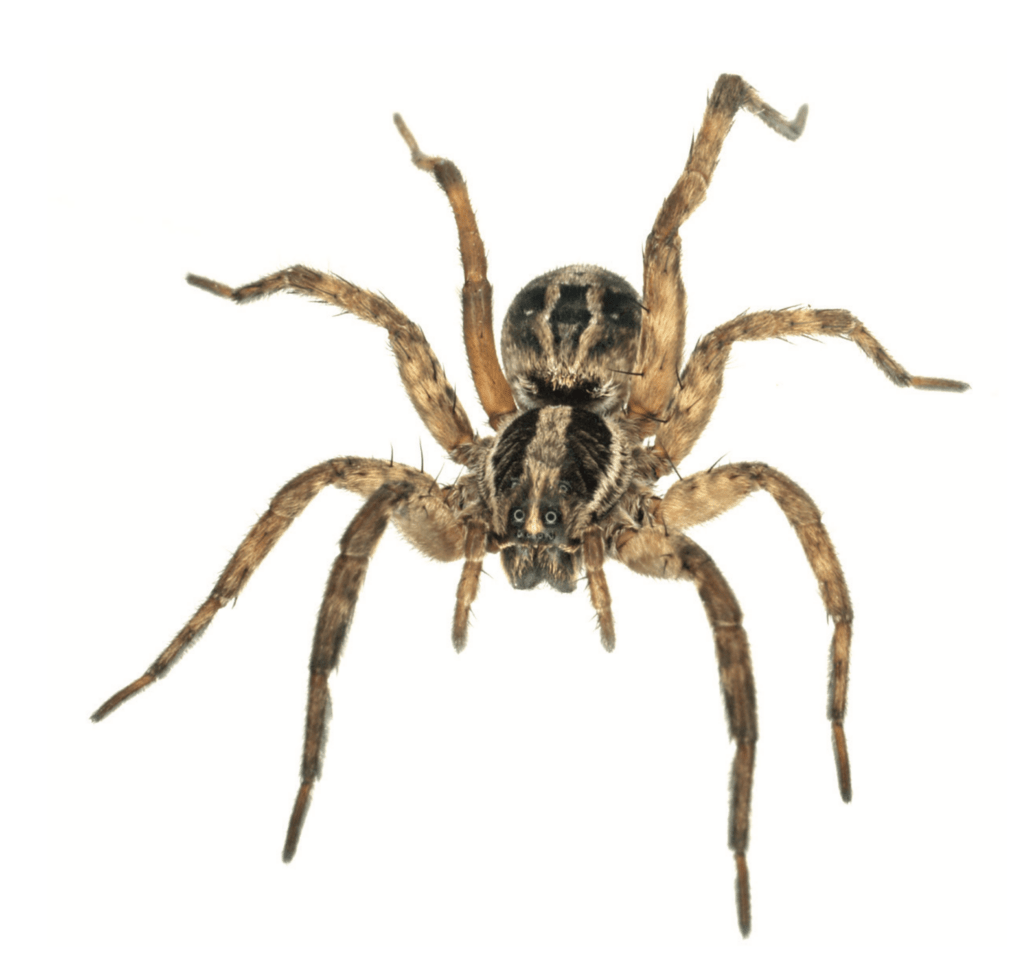
Why Should You Know About Nebraska Spiders?
Understanding the spiders in our environment can help in:
- Recognizing beneficial spiders that control pests.
- Identifying potential threats and knowing when to call professionals.
- Appreciating the biodiversity of our beautiful state.
H2: Basic Spider Biology
Anatomy and Physiology
All spiders, whether in Nebraska or elsewhere, share certain characteristics:
- Two main body parts: The carapace (front) and the abdomen (rear).
- Eight legs: This is a primary distinction from insects, which have six.
- Eyes: Most spiders have eight eyes, but some species might have six.
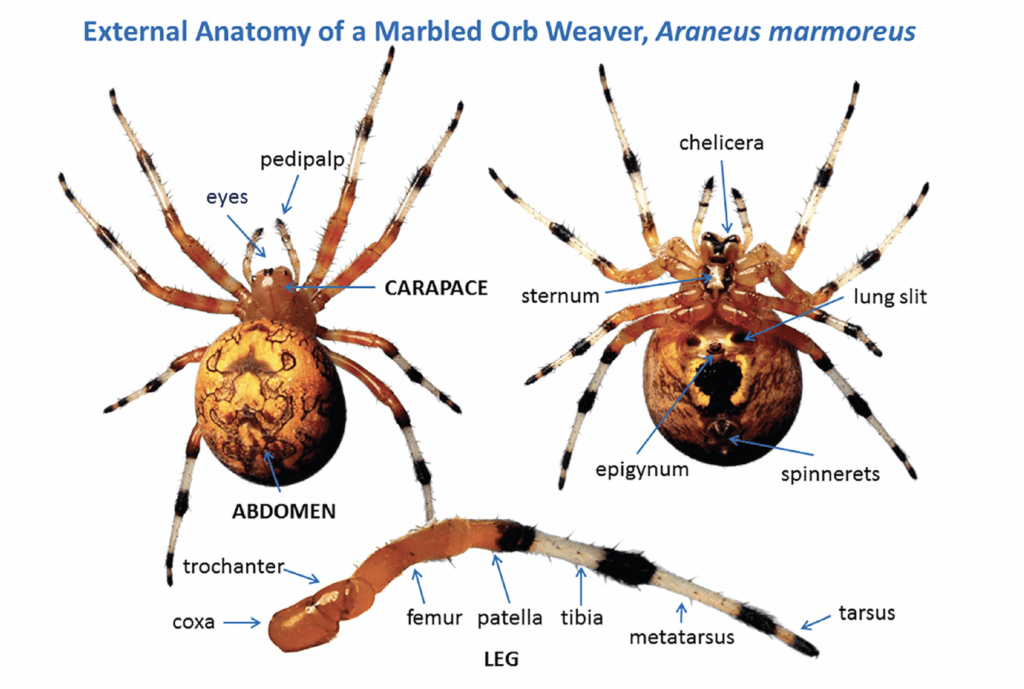
Prey Capture and Feeding
Spiders are nature’s pest controllers. They don’t chew their food. Instead, they capture insects, immobilize them with venom, and consume the liquefied insides.
Common Nebraska Spiders
Web-Building Spiders
These spiders use their webs as a primary tool for capturing prey.
Cellar Spiders (Family Pholcidae)
Often found in dark spaces, they spin irregular webs and hang upside down. When prey is trapped, they shake the web to ensnare it further.
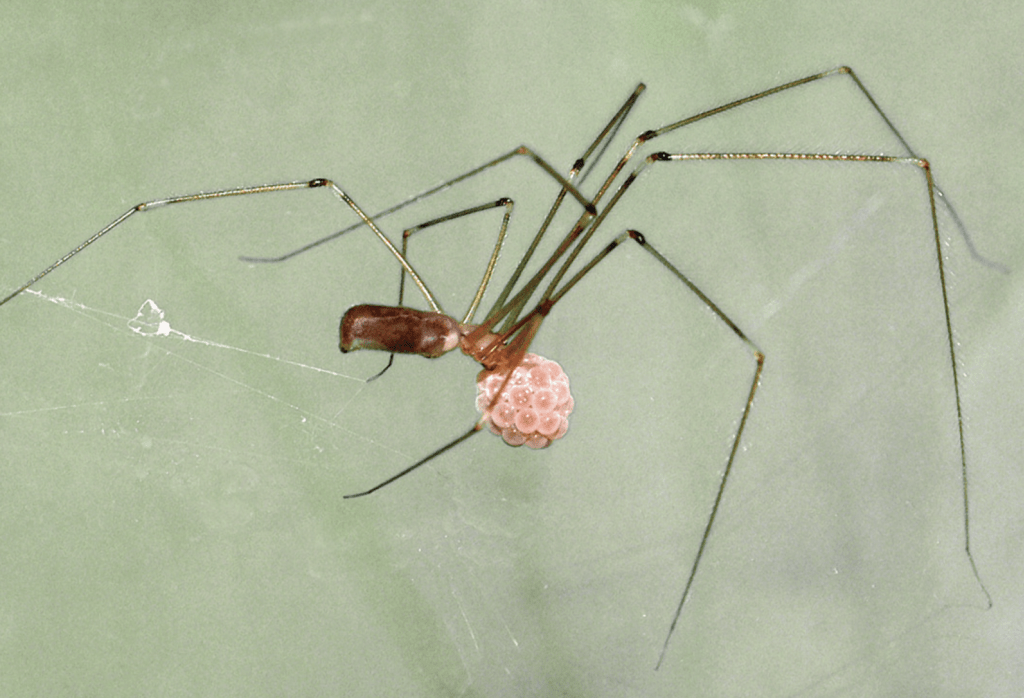
Cellar Spiders are usually found in crawl spaces, cellars, basements, outbuildings, and under fallen logs or objects on the ground. They spin an irregular tangle of webs from which they hang upside down. In protected areas such as crawl spaces, the masses of webs accumulate and can be very extensive. When an insect encounters a cob-web, the spider rapidly shakes the web to confuse and entrap its prey. The spider then covers it with silk to immobilize it. Typical prey are small flies, gnats, beetles, and tiny wasps. Cellar spider females carry their spherical-shaped mass of eggs in their pedipalps until they hatch. They are sometimes confused with brown recluse spiders because of the dark marking on the carapace and unusual eye pattern.
Body: small (0.2-0.3 inch) with a cylindrical abdomen that is brown to cream-colored.
Legs: thin, thread-like, and very long (up to 2 inches).
Eyes: eight eyes, raised above the carapace on a “bump”; six eyes in two clusters, and most species have a pair of smaller middle eyes (Figure 9).
Web: Network of irregular threads or tangled masses of fine silk (Figure 8).
Egg sac: Spherical, almost bare, with very little silk; 20-30 eggs (Figure 7).
Habitat: dark spaces, cellars, caves, or underleaf debris found on the ground.|
Behavior: Suspended upside down in web; crawls slowly and clumsily; shakes web when disturbed.
Cobweb Weaver Spiders
Includes the common house spider and the notorious widow spiders. They are reclusive, hanging upside down in their webs, waiting for prey.
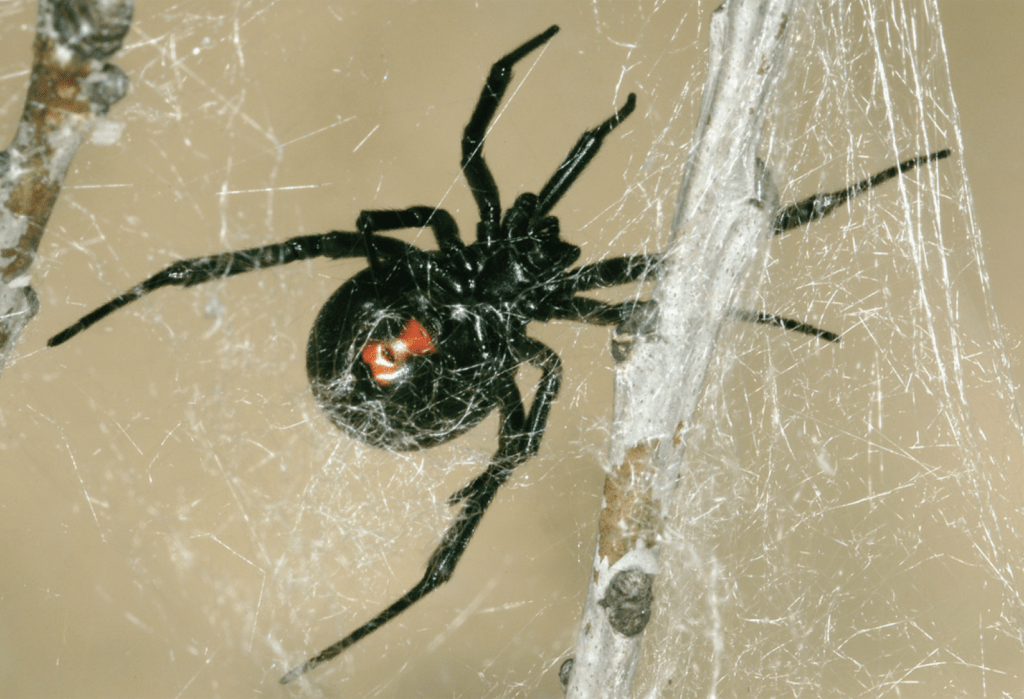
Cobweb weaver spiders move slowly and are not aggressive. They are generally reclusive, waiting for insects to be caught in their irregular maze webs. Once prey is detected, these spiders use the combs on their hind legs to quickly wrap their prey with a film of fine silk drawn from spinnerets. ‘The spider then bites its prey to inject venom to immobilize it further and predigest the body’s interior. Afterward, it feeds for a considerable time and then releases the carcass to the ground. ‘The most common prey of cobweb weaver spiders are flies, moths, roaches, ants, crickets and millipedes (Figure 14). Those inside homes build webs in corners, crevices, shelves, overhangs, or window wells.
Only the widow spiders in this group produce a neurotoxic venom potentially harmful to humans and animals. They should be avoided or eliminated from places where there is human activity. In Nebraska, the western black widow Latrodectus hesperus, is most common (Figures 11 and 12). The southern black widow, Latrodectus mactans, is occasionally found on freight and furniture transported from the southern United States.
Body: Small to medium (0.1-0.6 inch) with a large globular abdomen.
Legs: Relatively short; tips of hind legs have a fine comb of hairs.
Eyes: Eight eyes arranged in two rows form an oblong circular pattern in the center of the face.
Web: irregular, scaffold-type webs with sticky strands attached to surfaces (Figure 11).
Egg Sac: Usually spherical with a tough, leathery silk covering; others with a cottony or fluffy surface.
Habitat: found in various protected locations in landscapes and in and around structures.
Behavior: reclusive; hangs upside down motionlessly in the web and not aggressive until prey is snared; retreats when disturbed.
Sheetweb Spiders (Family Linyphidae)
Common in agricultural fields, they create flat or dome-shaped webs.
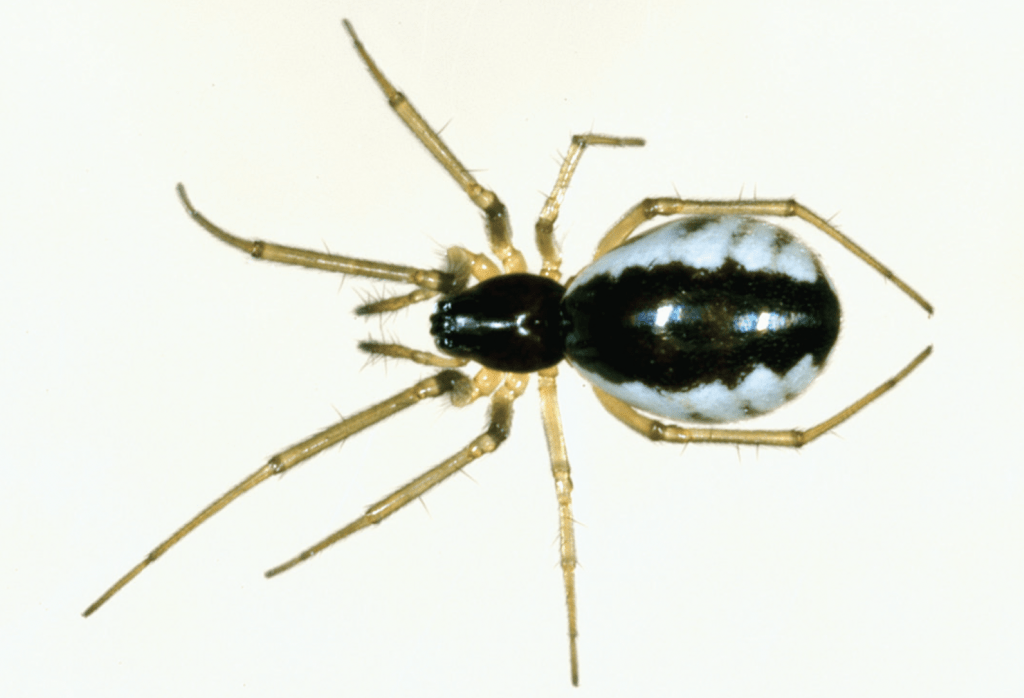
Sheetweb spiders belong to a large family of many small spider species. Some that live near the ground are so tiny that they are often not seen. Sheetweb spiders can be found in the landscape in ground litter, low vegetation, or among foliage and stems of bushes or tall grasses. They are one of the most common groups in agricultural fields. They are also active around structures in cellars, window wells, and crawl spaces beneath homes. The loose webs consist of one or more horizontal sheets closely spaced and connected above and below with support lines of silk. They may be flat, dome-shaped, or bowl-shaped.
The bowl and doily spider, Frontinella communis, is one of the more often observed species of sheetweb spiders. This spider creates a bowl-shaped web that measures about 6 inches across. The spider rests under the bottom of the bowl, seizes insects that become entangled and pulls them through the webbing to feed on them. ‘The filmy dome spider, Neriene radiata, creates a dome-shaped web that measures 3-5 inches in diameter. This spider rests under the dome’s peak and pulls entrapped insects through the web. Most species of sheet web spiders feed on small insects such as springtails, tiny moths, leafhoppers, plant bugs, and small flies.
Body: Tiny to small (0.05-0.2 inch) with an ovoid abdomen.
Legs: Relatively long.
Eyes: Eight eyes arranged in two rows that form an oblong circular pattern in the center of the face.
Web: sheet-like, dome-shaped, bowl-shaped, or irregular webs (2-8 inches in diameter), usually suspended horizontally like a trapeze net.
Egg sac: usually circular and flattened with a papery covering; attached away from webs just above the ground on plants, leaf litter, bark, logs, or stones, or sometimes in the soil.
Habitat: gaps in dense shrubbery, on the ground among plant debris, and low vegetation such as grasses and shrubs.
Behavior: cautious when suspended below the web; quickly retreats when disturbed. Drops depleted prey onto structural webbing or to the ground.
Spider Management and Control
While spiders are crucial in controlling pests, some species can be a nuisance or pose health risks.
Here’s what you can do:
Regular Inspection: Check common spider habitats like basements, attics, and crawl spaces.
Preventive Measures: Seal cracks, install window screens, and maintain cleanliness.
Professional Help: If you notice an infestation or come across potentially harmful spiders, it’s time to call Scott’s Pest Control.
Why Choose Scott’s Pest Control?

With years of experience in Omaha, we’re experts in pest control and understanding the local ecosystem. Facing a spider infestation in Nebraska?
Here’s why Scott’s Pest Control should be your go-to solution:
Effective Elimination: We prioritize swift and thorough eradication, ensuring that spiders are effectively dealt with to provide a pest-free environment.
Industry Leaders: Our team is always updated with the latest pest control techniques, methodologies, and best practices, drawing insights from trusted sources like Yoast, SEMRUSH, and Google.
Local Expertise: With a deep understanding of Omaha’s ecosystem and its unique pest challenges, we offer tailored solutions that address the specific needs of every home.
Choose Scott’s Pest Control for a decisive response to your spider concerns, ensuring your home remains a safe and comfortable space.
Conclusion
Nebraska’s spiders are a fascinating and essential part of our ecosystem. While they play a crucial role in controlling pests, knowing which ones are harmless and require professional intervention is essential. At Scott’s Pest Control in Omaha, we help you with pest-related concerns.
Remember, spiders are an integral part of our environment. If you have concerns about spiders in your home or want to learn more, don’t hesitate to contact Scott’s Pest Control. We’re here to help!
Reference: Identification Guide to, Common Spiders in Nebraska
Ronald C. Seymour, Extension Educator James A. Kalisch, Entomology Extension Associate Shripat T. Kamble, Extension Urban Entomologist




